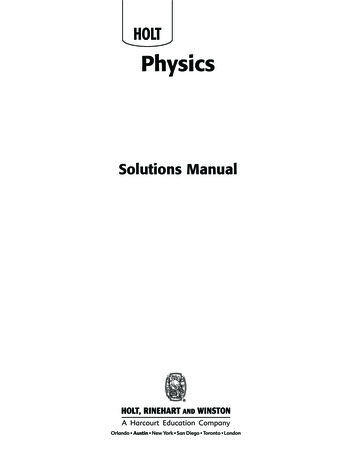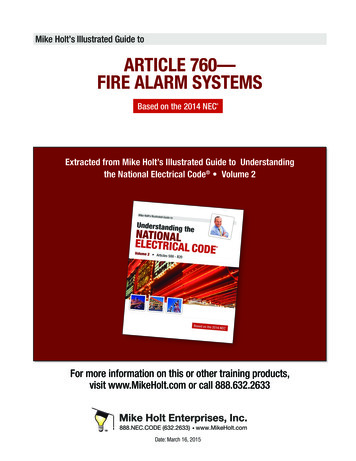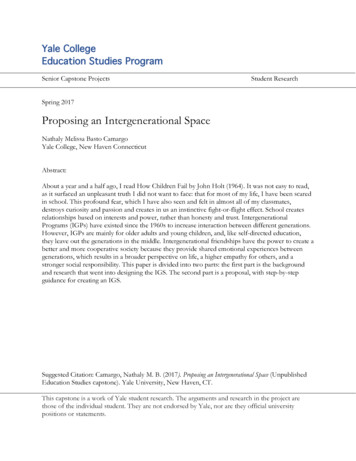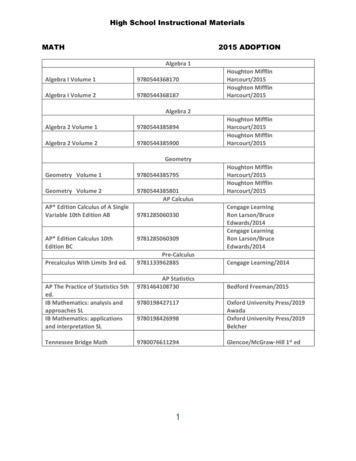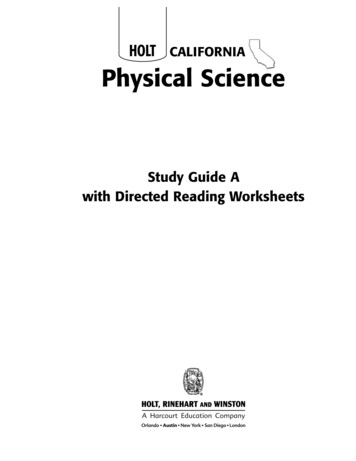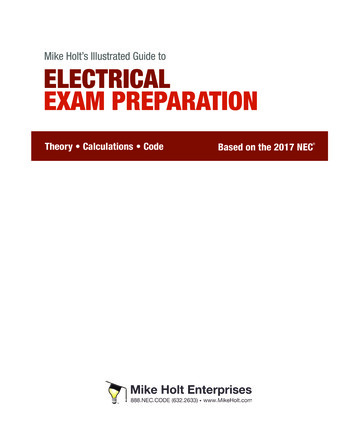
Transcription
Mike Holt’s Illustrated Guide toELECTRICALEXAM PREPARATIONTheory Calculations CodeBased on the 2017 NEC
CHAPTER1ELECTRICALTHEORYESSENTIAL FOR JOURNEYMANAND MASTER/CONTRACTORLICENSING EXAMSUnit 1 Electrician’s Math and Basic Electrical FormulasUnit 2 Electrical CircuitsUnit 3 Understanding Alternating CurrentUnit 4 Motors and TransformersNote: This chapter is a practice review of theory as it relates to basic electrical formulas andcalculations. Most state electrical exams include questions on general electrical theory andyou need a solid foundation to pass your exam. If, after working through this chapter, youfeel like you need additional in-depth training on theory, then Mike Holt’s Theory DVD TrainingProgram (textbook and DVDs) will give you a comprehensive understanding of this topic.For additional help, visit www.MikeHolt.com/Theory or call 888.632.2633 to order your copy.Mike Holt Enterprises www.MikeHolt.com 888.NEC.CODE (632.2633)7
Notes8Mike Holt’s Illustrated Guide to Electrical Exam Preparation, Based on the 2017 NEC
UNIT1ELECTRICIAN’S MATH ANDBASIC ELECTRICAL FORMULASIntroduction to Unit 1—Electrician’s Math and Basic Electrical FormulasIn order to construct a building that will last into the future, a strong foundation is a prerequisite. The foundation is a part of thebuilding that isn’t visible in the finished structure, but is essential in erecting one that will have the necessary strength to endure.The math and basic electrical concepts of this unit are very similar to the foundation of a building. The concepts presented hereare the essential basics that you must understand, because you’ll build upon them as you study electrical circuits and systems.As your studies continue, you’ll find that a good foundation in electrical theory and math will help you understand why the NECcontains certain provisions.This unit includes math and electrical fundamentals. You’ll be amazed at how often your electrical studies return to the basicsof this unit. Ohm’s law and the electrical formulas related to it are the foundation of all electrical circuits.Every student begins at a different level of understanding, and you may find this unit an easy review, or you may find it requiresa high level of concentration. In any case, be certain that you fully understand these concepts and are able to successfullycomplete the questions at the end of this unit before going on. A solid foundation will help in your successful study of the restof this textbook.Part A—Electrician’s Math1.1 Whole NumbersIntroductionWhole numbers are exactly what the term implies. These numbers don’tcontain any fractions, decimals, or percentages. Another name for wholenumbers is “integers.”Numbers can take different forms:Whole numbers: 1, 20, 300, 4,000, 5,000Decimals: 0.75, 0.80, 1.15, 1.25Fractions: 1/2, 1/4, 5 8, 4 3Percentages: 80%, 125%, 250%, 500%1.2 DecimalsYou’ll need to be able to convert these numbers from one form to anotherand back again, because all of these number forms are part of electricalwork and electrical calculations.The decimal method is used to display numbers other than wholenumbers, fractions, or percentages such as, 0.80, 1.25, 1.732, and so on.You’ll also need to be able to do some basic algebra. Many people areapprehensive of algebra, but as you work through the material hereyou’ll see there’s nothing to fear.Mike Holt Enterprises www.MikeHolt.com 888.NEC.CODE (632.2633)9
Unit 1 Electrician’s Math and Basic Electrical FormulasPercentages, Converting to Decimals, Example1.3 FractionsA fraction represents part of a whole number. If you use a calculator foradding, subtracting, multiplying, or dividing, you’ll need to convert thefraction to a decimal or whole number. To do so, divide the numerator(the top number) by the denominator (the bottom number). }Figure 1–1Fractions1/ 411/ 2Drop “%”Percentage32.50% 0 325%Decimal0 32580%0 80%0 80125%1 25%1 25250%2 50%2 503/ 4Move the decimal point two places to the left.Copyright 2017, www.MikeHolt.com}Figure 1–21/ 411/ 23/ 4A fraction represents part of awhole, such as 1/ 4, 1/ 2, and 3 / 4.Copyright 2017, www.MikeHolt.com}Figure 1–11.5 MultiplierWhen a number needs to be changed by multiplying it by a percentage,the percentage is called a multiplier. The first step is to convert thepercentage to a decimal, then multiply the original number by thedecimal value. Examples Example 1 6 one divided by six 0.1662 5 two divided by five 0.403 6 three divided by six 0.505 4 five divided by four 1.257 2 seven divided by two 3.50Question: An overcurrent protection device (circuit breaker or fuse)must be sized no less than 125 percent of the continuous load. Ifthe load is 80A, the overcurrent protection device will have to besized no smaller than . }Figure 1–31(a) 75A(b) 80A(c) 100A(d) 125AUsing a MultiplierExample1.4 PercentagesConductors must be sized no less than125 percent of the continuous load.A percentage is another method used to display a value. One hundredpercent (100%) means all of a value, fifty percent (50%) means one-halfof a value, and twenty-five percent (25%) means one-fourth of a value.Convert 125% to a decimal 1.25 multiplierMultiply 80A x 1.25 100A device}Figure 1–3Mike Holt’s Illustrated Guide to Electrical Exam Preparation, Based on the 2017 NECJalapenoFlavoredSodaCopyright 2017, For convenience in multiplying or dividing by a percentage, convertthe percentage value to a whole number or decimal, and then use theresult for the calculation. When changing a percent value to a decimalor whole number, drop the percentage symbol and move the decimalpoint two places to the left. }Figure 1–2
Electrician’s Math and Basic Electrical Formulas Unit 1Answer: (c) 100A Example 1Step 1: Convert 125 percent to a decimal: 1.25How do you increase the whole number 16 by 25 percent?Step 2: Multiply the value of the 80A load by 1.25 100AStep 1: Convert 25 percent to decimal form: 0.25Step 2: Add one to the decimal value to obtain the multiplier:1 0.25 1.25 Example 2Question: The maximum continuous load on an overcurrent protection device is limited to 80 percent of the device rating. If it’s rated50A, what’s the maximum continuous load permitted on the overcurrent protection device? }Figure 1–4(a) 40A(b) 50A(c) 75A(d) 100AUsing a MultiplierExampleThe circuit supplies a40A continuous load.Step 3: Multiply 16 by the multiplier 1.25: 16 1.25 20 Example 2Question: If the feeder demand load for a range is 8 kW and it’srequired to be increased by 15 percent, the total calculated loadwill be . }Figure 1–5(a) 6.80 kW(b) 8 kW(c) 9.20 kW(d) 15 kWPercent IncreaseExampleContinuous loads are limitedto 80% of the overcurrentdevice rating.To increase 8 kWby 15 percent:Convert 15 percentto a decimal 0.15Convert 80% to a decimal 0.80 multiplier50A device x 0.80 40A continuous load50A Overcurrent DeviceAdd a 1 1.15 multiplierRange Rated8 kW8 kW x 1.15 9.20 kW calculated loadCopyright 2017, www.MikeHolt.com}Figure 1–4Answer: (a) 40ACopyright 2017, www.MikeHolt.com}Figure 1–5Step 1: Convert 80 percent to a decimal: 0.80Step 2: Multiply the value of the 50A device rating by0.80 40AAnswer: (c) 9.20 kWStep 1: Convert the percentage increase required to decimalform: 15 percent 0.15Step 2: Add one to the decimal: 1 0.15 1.151.6 Percent IncreaseUse the following steps to increase a number by a specific percentage:Step 3: Multiply 8 by the multiplier 1.15: 8 kW 1.15 9.20 kWStep 1: Convert the percentage to a decimal value.Step 2: Add one to the decimal value to create the multiplier.Step 3: Multiply the original number by the multiplier found in Step 2.Mike Holt Enterprises www.MikeHolt.com 888.NEC.CODE (632.2633)11
Unit 1 Electrician’s Math and Basic Electrical Formulas1.7 Reciprocals1.8 Squaring a NumberTo obtain the reciprocal of a number, convert it into a fraction with thenumber one as the numerator (the top number). It’s also possible tocalculate the reciprocal of a percentage number. Determine the reciprocal of a percentage number by following these steps:Step 1: Convert the number to a decimal value. Example 1(c) 125% Example 1Power(P) I 2 RQuestion: What’s the reciprocal of 80 percent?(b) 100%102 10 10 100 or 232 23 23 529Question: What’s the power consumed in watts by a 12 AWGconductor that’s 200 ft long, and has a total resistance (R) of 0.40ohms, if the current (I) in the circuit conductors is 16A? (Answersare rounded to the nearest 50). }Figure 1–6Step 2: Divide the value into the number one.(a) 0.80Squaring a number means multiplying the number by itself.(d) 150%(a) 50W(b) 100WAnswer: (c) 125%16AmpsStep 2: Divide 0.80 into the number one:1/0.80 1.25 or 125 percentFormula:P I2 x RI (Intensity, Amps) 16AR (Circuit Resistance) 0.40 ohmsP 16A2 x 0.40 ohmsP (16A x 16A) x 0.40 ohmsP 256A x 0.40 ohmsP 102.40W Example 2Question: What’s the reciprocal of 125 percent?(b) 0.80(c) 100%Answer: (b) 0.80(d) 125%Squaring a number is the value derivedwhen you multiply the number by itself.Copyright 2017, www.MikeHolt.com}Figure 1–6Step 1: Convert 125 percent into a decimal:125 percent 1.25Answer: (b) 100WStep 2: Divide 1.25 into the number one:1/1.25 0.80 or 80 percentP I2 RI 16AR 0.40 ohmsP 16A2 0.40 ohmsP (16A 16A) 0.40 ohmsP 102.40W12(d) 200WSquaring a Number, ExampleStep 1: Convert 80 percent into a decimal (move the decimaltwo places to the left): 80 percent 0.80(a) 75%(c) 150WMike Holt’s Illustrated Guide to Electrical Exam Preparation, Based on the 2017 NECCircuitResistance0.40 ohms
Electrician’s Math and Basic Electrical Formulas Unit 1 Example 2 Example 4Question: What’s the area in square inches (sq in.) of a trade size1 raceway with an inside diameter of 1.049 in.?Question: What’s the sq in. area of a 16-in. pizza? }Figure 1–8(a) 100 sq in.Area π rπ 3.14r radius (equal to 0.50 of the diameter)(b) 150 sq in.(c) 200 sq in.(d) 256 sq in.2(a) 0.34 sq in.(b) 0.50 sq in.Squaring, Example8-in. Diameter16-in. Diameter(c) 0.86 sq in. (d) 1 sq in.Answer: (c) 0.86 sq in.Area π r 2Area 3.14 (0.50 1.049) 2Area 3.14 0.5245 2Area 3.14 (0.5245 0.5245)Area 3.14 0.2751Area 0.86 sq in.50 sq in.If you double the diameterof a circle, the area increasesby a factor of four.Area π x r 2Area 3.14 x (0.50 x 16) 2Area 3.14 x 82Area 3.14 x (8 x 8)Area 3.14 x 64Area 200 sq in.Copyright 2017, www.MikeHolt.com Example 3}Figure 1–8Question: What’s the sq in. area of an 8-in. pizza? }Figure 1–7(a) 25 sq in.(b) 50 sq in.(c) 64 sq in.(d) 75 sq in.Squaring, Example8-in. Diameter16-in. DiameterAnswer: (c) 200 sq in.Area π r 2Area 3.14 (0.50 16) 2Area 3.14 8 2Area 3.14 (8 8)Area 3.14 64Area 200 sq in.Author’s Comment:Area π x r 2Area 3.14 x (0.50 x 8) 2Area 3.14 x 4 2Area 3.14 x (4 x 4)Area 3.14 x 16Area 50 sq in.Copyright 2017, www.MikeHolt.comnAs you see in Examples 3 and 4, if you double the diameter ofthe circle, the area contained within it is increased by a factorof four! By the way, a large pizza is always cheaper per sq in.than a small one.}Figure 1–7Answer: (b) 50 sq in.Area π r 2Area 3.14 (0.50 8) 2Area 3.14 4 2Area 3.14 (4 4)Area 3.14 16Area 50 sq in.1.9 ParenthesesWhenever numbers are in parentheses, complete the mathematical function within the parentheses before proceeding with the rest of the problem.Parentheses are used to group steps of a process into the correctorder. For instance, adding the sum of 3 and 15 to the product of 4 and2 equals 26.(3 15) (4 2) 18 8 26Mike Holt Enterprises www.MikeHolt.com 888.NEC.CODE (632.2633)13
Unit 1 Electrician’s Math and Basic Electrical Formulas Example 3: Following your calculator’s instructions, enter the number 3, thenpress the square root key 1.732.Question: What’s the current of a 36,000W, 208V, three-phaseload? }Figure 1–9 1,000: Enter the number 1,000, then press the square root key 31.62.Amperes Watts /(Volts 1.732)Amperes (I), Watts (P), Volts (E)(a) 50A(b) 100A(c) 150A(d) 360AIf your calculator doesn’t have a square root key, don’t worry aboutit. For all practical purposes in using this textbook, the only numberyou need to know the square root of is 3. The square root of 3 equalsapproximately 1.732.To add, subtract, multiply, or divide a number by a square root value,determine the decimal value and then perform the math function.Math in ParenthesesExampleM Example 1ONQuestion: 36,000W/(208V 3) is equal to .OFFONOFF208V1I P(E x 3)I 36,000W Load3-Phase36,000W36,000WI 100A360(208V x 1.732)Whenever numbers are in parentheses, completethe mathematical function within them beforeproceeding with the rest of the problem.(a) 100A(b) 120A(c) 208A(d) 360AAnswer: (a) 100AStep 1: Determine the decimal value for the 3 1.732Step 2: Divide 36,000W by (208V 1.732) 100ACopyright 2017, www.MikeHolt.com Example 2}Figure 1–9Question: The phase voltage of a 120/208V system is equal to208V/ 3, which is .Answer: (b) 100AStep 1: Perform the operation inside the parentheses first—determine the product of: 208V 1.732 360V(a) 120V(b) 208V(c) 360V(d)480VStep 2: Divide 36,000W by 360V 100AStep 1: Determine the decimal value for the 3 1.732Answer: (a) 120VStep 2: Divide 208V by 1.732 120V1.10 Square RootDeriving the square root of a number ( n) is the opposite of squaringa number. The square root of 36 is a number that, when multiplied byitself, gives the product 36. The 36 equals six, because six, multipliedby itself (which can be written as 62) equals the number 36.Because it’s difficult to do this manually, just use the square root keyof your calculator.141.11 VolumeThe volume of an enclosure is expressed in cubic inches (cu in.). It’sdetermined by multiplying the length, by the width, by the depth of theenclosure.Mike Holt’s Illustrated Guide to Electrical Exam Preparation, Based on the 2017 NEC
Electrician’s Math and Basic Electrical Formulas Unit 1 Example Example 1Question: What’s the volume of a box that has the dimensions of4 in. 4 in. 1½ in.? }Figure 1–10Question: What’s the wattage value for an 8 kW rated range?(a) 12 cu in.(b) 20 cu in.(c) 24 cu in.(d) 30 cu in.(a) 8W(b) 800W(c) 4,000W(d) 8,000WAnswer: (d) 8,000WVolume, ExampleTo convert a unit value to a “k” value, divide the number by 1,000 andadd the “k” suffix.Volume Cu In.Cu In. Length x Width x Depth4 in.Cu In. 4 in. x 4 in. x 1 1/2 in.(Convert the fraction to adecimal and add the 1.)1 (1 divided by 2 1.50 in.Cu In. 4 in. x 4 in. x 1.50Volume 24 cu in.24 cu in.4 in. Example 2Question: What’s the kW rating of a 300W load? }Figure 1–11(a) 0.30 kW1 1/2 in.(b) 30 kW(c) 300 kW(d) 3,000 kWKilo - Converting Watts to kW, ExampleVolume in cubic inches can be determined by multiplyingthe length, by the width, by the depth of the enclosure.Copyright 2017, www.MikeHolt.com}Figure 1–10Answer: (c) 24 cu in.300W/1,000 0.30 kW Load300W Load1½ 1.504 4 1.50 24 cu in.Watts can be converted to kWby dividing the watts by 1,000.Author’s Comment:nCopyright 2017, www.MikeHolt.comThe actual volume of a 4 in. square electrical box is less than24 cu in. because the interior dimensions may be less thanthe nominal size and corners are often rounded, so the allowable volume is given in the NEC, Table 314.16(A).}Figure 1–11Answer: (a) 0.30 kWkW Watts/1,000kW 300W/1,000 0.30 kW1.12 KiloThe letter “k” is used in the electrical trade to abbreviate the metricprefix “kilo,” which represents a value of 1,000.To convert a number which includes the “k” prefix into units, multiplythe number preceding the “k” by 1,000.Author’s Comment:nThe use of the letter “k” isn’t limited to “kW.” It’s also usedfor kVA (1,000 volt-amperes), kcmil (1,000 circular mils) andother units such as kft (1,000 feet).Mike Holt Enterprises www.MikeHolt.com 888.NEC.CODE (632.2633)15
Unit 1 Electrician’s Math and Basic Electrical Formulas1.13 Rounding Off ExampleThere’s no specific rule for rounding off, but rounding to two or three“significant digits” should be sufficient for most electrical calculations.Numbers below five are rounded down, while numbers five and aboveare rounded up.Question: The input of a transformer is 300W; the transformer efficiency is 90 percent. What’s the transformer output? }Figure 1–12(a) 270W 0.1245—the fourth number is five or above 0.125 rounded up 367.20—the fourth number is below five 367 rounded down(c) 333W(d) 500WTesting Your Answer for ReasonablenessExample 1.674—the fourth number is below five 1.67 rounded down 21.99—the fourth number is five or above 22 rounded up(b) 300WOutput270 WattsInput300 WattsMultipleChoiceSelections(a) 270W(b) 300W(c) 333W(d) 500WRounding Answers for Multiple Choice QuestionsYou should round your answers in the same manner as the multiplechoice selections given in the question.90% EfficientSince output can’t be greater than input, you’ll knowthe answer must be less than 300W. There’s only oneoption less than 300W, so no calculation is necessary. ExampleCopyright 2017, www.MikeHolt.comQuestion: The sum* of 12, 17, 28, and 40 is equal to .(a) 70(b) 80(c) 90(d) 100Answer: (d) 100Answer: (a) 270W*A sum is the result of adding numbers.Since the output must be less than the input (300W), you won’thave to perform any mathematical calculation because the onlymultiple choice selection that’s less than 300W is (a) 270W.The sum of these values equals 97, but that answer isn’t listedas one of the choices. The multiple choice selections in this caseare rounded off to the closest “tens.”1.14 Testing Your Answer for ReasonablenessWhen working with any mathematical calculation, don’t just blindly dothe calculation and assume it’s correct. When you perform a mathematical calculation, you need to know if the answer is greater than or lessthan the values given in the problem. Always do a “reality check” to becertain your answer isn’t nonsense. Even the best of us make mistakesat times, so always examine your answer to be sure it makes sense!16}Figure 1–12The math to work out the answer is:300W 0.90 270WTo check your multiplication, use division:270W/0.90 300WAuthor’s Comment:nOne of the nice things about mathematical equations is thatyou can usually test to see if your answer is correct. To do thistest, substitute your answer back into the equation with whichyou’re working and verify that it indeed equals out correctly. Thismethod of checking your math will become easier once youknow more of the formulas and how they relate to each other.Mike Holt’s Illustrated Guide to Electrical Exam Preparation, Based on the 2017 NEC
Electrician’s Math and Basic Electrical Formulas Unit 1Part B—Basic Electrical Circuits and FormulasIntroductionMany false notions about the application of Article 250—Grounding andBonding, and Chapter 3—Wiring Methods and Materials (both in theNEC ) arise when people only use Ohm’s Law to solve practice problemson paper but lack a real understanding of how that law works and howit should be applied. After completing this unit, you’ll have that understanding, and won’t be subject to those false notions—or the unsafeconditions to which they lead.But we won’t stop with Ohm’s Law. You’re also going to have a high levelof proficiency with the power equation. One of the tools for handling thepower equation with ease—and Ohm’s Law—is the power wheel. Withit, you’ll be able to solve all kinds of problems.1.16 Power SourceThe power necessary to move electrons out of their orbit around thenucleus of an atom can be produced by chemical, magnetic, photovoltaic, and other means. The two categories of power sources are directcurrent (dc) and alternating current (ac).Direct CurrentThe polarity and the output voltage from a direct-current power sourcenever change direction. One terminal is negative and the other is positive,relative to each other. Direct-current power is often produced by batteries,direct-current generators, and electronic power supplies. }Figure 1–14Power Source, Direct Current1.15 Electrical CircuitA basic electrical circuit consists of the power source, the conductors,and the load. A switch can be placed in series with the circuit conductors to control the operation of the load (turning it on or off). }Figure 1–13The Electron Current Flow Theorystates that current travels fromnegative (-) to positive ( ). Constant dcWaveformLoad0Electrical CircuitSwitchConductorThe polarity and the output voltage from a dc power sourcenever change direction. One terminal is negative and theother is positive. DC power is often produced by batteries.ProtectionDeviceCopyright 2017, www.MikeHolt.com}Figure 1–14PowerSourceLoad(Appliance orEquipment)ConductorAn electrical circuit consists of the power source, theconductors, and the load. A protective device and switchcan be placed in series with the circuit conductors.Copyright 2017, www.MikeHolt.com}Figure 1–13Direct current is used for electroplating, street trolley and railway systems,or where a smooth and wide range of speed control is required for amotor-driven application. Direct current is also used for control circuitsand electronic instruments.Alternating CurrentAlternating-current power sources produce a voltage that changespolarity and magnitude. Alternating current is produced by an alternatingcurrent power source such as an alternating-current generator. The majoradvantage of alternating current over direct current is that voltage canbe changed through the use of a transformer. }Figure 1–15Mike Holt Enterprises www.MikeHolt.com 888.NEC.CODE (632.2633)17
Unit 1 Electrician’s Math and Basic Electrical FormulasAlternating Current (ac)NSN(1)SN(2)S1.18 Circuit ResistanceN(3)SN(4)S(5)Positiveac Waveform 0( )Magnitude( )Circuit Resistance NegativeCurrent andVoltageThe total resistance of a circuit includes the resistance of the powersupply, the circuit wiring, and the load. Appliances such as heaters andtoasters use high-resistance conductors to produce the heat neededfor the application. Because the resistances of the power source andconductor are so much smaller than that of the load, they’re generallyignored in circuit calculations. }Figure 1–17Copyright 2017, www.MikeHolt.comLow Resistance(Can be Less Than 1 Ohm)}Figure 1–15Power Source hasVery Low ResistanceAuthor’s Comment:nWire - 100 ft 12 AWG0.20 ohmsProtectiveDeviceAlternating current accounts for more than 90 percent of allelectric power used throughout the world.190-OhmLoadLoads Have theHighest ResistanceWire - 100 ft 12 AWG0.20 ohmsThe total resistance of a circuit includes the powersupply, circuit wiring, and the load. The resistanceof the power source will be ignored in this textbook.1.17 ConductanceCopyright 2017, www.MikeHolt.comConductance, or conductivity, is the property of a metal that permitscurrent to flow. The best conductors in order of their conductivity aresilver, copper, gold, and aluminum. Copper is most often used for electrical applications. }Figure 1–16Conductance of Conductor Material at 75oC}Figure 1–171.19 Ohm’s LawOhm’s Law expresses the relationship between a direct-current circuit’scurrent intensity (I), electromotive force (E), and its resistance (R). Thisis expressed by the formula: I E/RAuthor’s Comment:SilverCopperGoldAluminumConductance is the property of metal that permitscurrent to flow. The best conductors in order ofconductivity are silver, copper, gold, and aluminum.Copyright 2017, www.MikeHolt.com}Figure 1–1618nThe symbol Ω represents “ohms.”nThe German physicist Georg Simon Ohm (1787–1854) statedthat current is directly proportional to voltage, and inverselyproportional to resistance.Direct proportion means that changing one factor results in a direct changeto another factor in the same direction and by the same magnitude.If the voltage increases 25 percent, the current increases 25 percent—in direct proportion (for a given resistance). If the voltage decreases 25percent, the current decreases 25 percent—in direct proportion (for agiven resistance). }Figure 1–18Mike Holt’s Illustrated Guide to Electrical Exam Preparation, Based on the 2017 NEC
Electrician’s Math and Basic Electrical Formulas Unit 1Ohm’s Law1.20 Ohm’s Law and Alternating CurrentCurrent is Directly Proportional to Voltage.240VI E/R120VVoltage(R) 10 ohms12ACurrent240V/10 ohms 24A24A120V/10 ohms 12ADirect proportion means that changing one factorresults in a direct change to another factor in thesame direction and by the same magnitude.Direct CurrentIn a direct-current circuit, the only opposition to current flow is the physical resistance of the material through which it flows. This opposition iscalled “resistance” and is measured in ohms.Alternating CurrentIn an alternating-current circuit, there are three factors that opposecurrent flow: the resistance of the material; the inductive reactance ofthe circuit; and the capacitive reactance of the circuit.Author’s Comment:Copyright 2017, www.MikeHolt.com}Figure 1–18nFor now, we’ll assume that the effects of inductance and capacitance on the circuit are insignificant and they’ll be ignored.Inverse proportion means that increasing one factor results in a decreasein another factor by the same magnitude, or a decrease in one factor willresult in an increase of the same magnitude in another factor.1.21 Ohm’s Law Formula CircleIf the resistance increases by 25 percent, the current decreases by25 percent—in inverse proportion (for a given voltage), or if the resistance decreases by 25 percent, the current increases by 25 percent—ininverse proportion (for a given voltage). }Figure 1–19Ohm’s Law, the relationship between current, voltage, and resistance expressed in the formula, E I R , can be transposed toI E/R or R E/I . In order to use these formulas, two of the valuesmust be known.Author’s Comment:Ohm’s LawCurrent is Inversely Proportional to Resistance.10 ohmsI E/R20 ohmsceResistan(E) 120V12ACurrent(2x)120V/10 ohms 12A(1/ 2)6A30 ohms}Figure 1–19Place your thumb on the unknown value in }Figure 1–20, andthe two remaining variables will “show” you the correct formula.(3x)Ohm’s Law Formula120V/20 ohms 6A4A(1/ 3)Inverse proportion means that increasing one factorresults in a decrease in another factor by the samemagnitude, or a decrease in one factor will result inan increase of the same magnitude in another factor.Copyright 2017, www.MikeHolt.comnE IxRVoltageECurrent ResistanceI REI REI E/RRIOhm’s Law CircleER E/IIRCopyright 2017, www.MikeHolt.com}Figure 1–20Mike Holt Enterprises www.MikeHolt.com 888.NEC.CODE (632.2633)19
Unit 1 Electrician’s Math and Basic Electrical Formulas Current ExampleDetermining Voltage Drop With Ohm’s Law, ExampleQuestion: 120V supplies a lamp that has a resistance of 192 ohms.What’s the current flow in the circuit? }Figure 1–21(a) 0.50A(b) 0.60A(c) 1.30A(d) 2.50A50 ft 12 AWG120EI R?“Known”VoltsAmpsDetermine the current ofa 120V, 192-ohm circuit.192 ohms“Known”EI R1.6120VAmps16Ohm’s Law, Current IntensityExampleR 0.10 ohmsVoltsEVD ?50 ft 12 AWGR 0.10 ohmsFormula: E VD I x RTo determine the voltage drop of conductors,use the resistance of conductors.Known: I 16A (given), R of each conductor 0.10 ohmsE VD I x RE VD 16A x 0.10 ohms 1.60VE VD 1.60V per conductorVoltage drop of both conductors 16A x 0.20 ohms 3.20VNote: Load operates at 120V - 3.20 VD 116.80VCopyright 2017, www.MikeHolt.com}Figure 1–22Formula: I E/RKnowns: E 120V, R 192 ohmsI ERI 120V192 ohmsI 0.625AStep 1: What’s the question? What’s “EVD”?Step 2: What do you know about the conductors?Copyright 2017, www.MikeHolt.comI 16A and R 0.20 ohms. The NEC lists the alternatingcurrent resistance of 1,000 ft of 12 AWG as 2 ohms[Chapter 9, Table 9]. The resistance of 100 ft is equal to0.20 ohms. }Figure 1–23}Figure 1–21Answer: (b) 0.60AStep 1: What’s the question? What’s “I”?Step 2: What do you know? E 120V, R 192 ohmsConductor ResistanceExampleStep 3: The formula is I E/RStep 4: The answer is I 120V/192 ohmsStep 5: The answer is I 0.625A Voltage-Drop ExampleQuestion: What’s the voltage drop (EVD ) of two 12 AWG conductors(resistance of 0.20 ohms per 100 ft) supplying a 16A load located50 ft from the power supply? }Figure 1–22To determine the resistance of 100 ft of 12 AWGNEC Chapter 9, Table 9, 1,000 ft of 12 AWG 2 ohms2 ohms/1,000 ft 0.002 ohms per ft0.002 ohms per ft x 100 ft 0.20 ohms for 100 ftCopyright 2017, www.MikeHolt.com(a) 1.60V(b) 3.20V(c) 16V(d) 32V}Figure 1–23Answer: (b) 3.20VStep 3: The formula is EVD I R .Step 4: The answer is EVD 16A 0.20 ohmsStep 5: The answer is EVD 3.20V20Mike Holt’s Illustrated Guide to Electrical Exam Preparation, Based on the 2017 NEC
Electrician’s Math and Basic Electrical Formulas Unit 1 Resistance ExampleAuthor’s Comment:Question: What’s the resistance of two circuit conductors when theconductor voltage drop is 3V and the current flowing in the circuitis 100A? }Figure 1–24n(a) 0.03 ohms(b) 2 ohms(c) 30 ohmsPlace your thumb on the unknown value in }Figure 1–25 andthe two remaining variables will “show” you the correct formula.(d) 300 ohmsDetermining Resistance of ConductorsExample1.5Power FormulaPCurrent VoltageR ?1.5I EPowerEI RVoltsI EAmpsVoltsPP IxE100I P/EPIPIE CircleFormula: R E/IPE P/IKnown: E of conductors, 1.50V 1.50V 3VD, I 100A3 VDER 100A 0.03 ohms for both conductorsR IR 0.015 ohms x 2 conductors 0.03 ohms, both conductorsEIECopyright 2017, www.MikeHolt.com}Figure 1–25Copyright 2017, www.MikeHolt.com}Figure 1–24 Power Loss ExampleAnswer: (a) 0.03 ohmsQuestion: What’s the power loss in watts for two conductors thatcarry 12A and have a voltage drop of 3.60V? }Figure 1–26Step 1: What’s the question? What’s “R”?St
10 Mike Holt’s Illustrated Guide to Electrical Exam Preparation, Based on the 2017 NEC Unit 1 Electrician’s Math and Basic Electrical Formulas 1.5 Multiplier When a number needs to be changed by multiplying it by a percentage, the percentage is File Size: 903KBPage Count: 41


